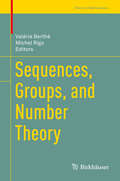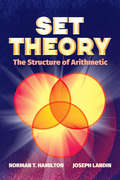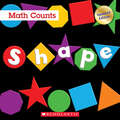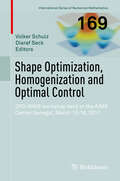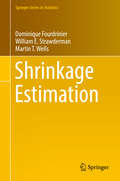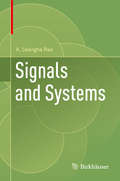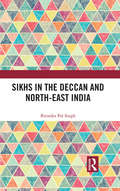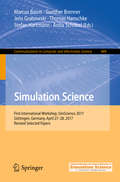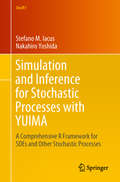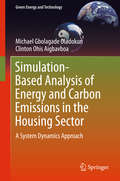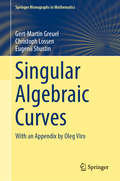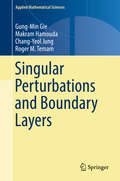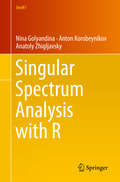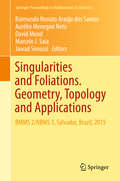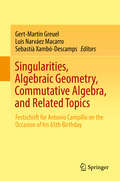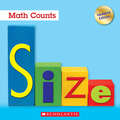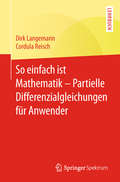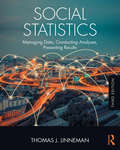- Table View
- List View
Sequences, Groups, and Number Theory
by Valérie Berthé Michel RigoThis collaborative book presents recent trends on the study of sequences, including combinatorics on words and symbolic dynamics, and new interdisciplinary links to group theory and number theory. Other chapters branch out from those areas into subfields of theoretical computer science, such as complexity theory and theory of automata. The book is built around four general themes: number theory and sequences, word combinatorics, normal numbers, and group theory. Those topics are rounded out by investigations into automatic and regular sequences, tilings and theory of computation, discrete dynamical systems, ergodic theory, numeration systems, automaton semigroups, and amenable groups. This volume is intended for use by graduate students or research mathematicians, as well as computer scientists who are working in automata theory and formal language theory. With its organization around unified themes, it would also be appropriate as a supplemental text for graduate level courses.
Set Theory: The Structure Of Arithmetic (Dover Books on Mathematics)
by Norman T. Hamilton Joseph LandinThis text is formulated on the fundamental idea that much of mathematics, including the classical number systems, can best be based on set theory. Beginning with a discussion of the rudiments of set theory, authors Norman T. Hamilton and Joseph Landin lead readers through a construction of the natural number system, discussing the integers and the rational numbers, and concluding with an in-depth examination of the real numbers. Drawn from lecture notes for a course intended primarily for high school mathematics teachers, this volume was designed to answer the question, "What is a number?" and to provide a foundation for the study of abstract algebra, elementary Euclidean geometry, and analysis. Upon completion of this treatment — which is suitable for high school mathematics teachers and advanced high school students — readers should be well prepared for introductory courses in abstract algebra and real variables.
Sets, Models and Proofs (Springer Undergraduate Mathematics Series)
by Ieke Moerdijk Jaap Van OostenThis textbook provides a concise and self-contained introduction to mathematical logic, with a focus on the fundamental topics in first-order logic and model theory. Including examples from several areas of mathematics (algebra, linear algebra and analysis), the book illustrates the relevance and usefulness of logic in the study of these subject areas.The authors start with an exposition of set theory and the axiom of choice as used in everyday mathematics. Proceeding at a gentle pace, they go on to present some of the first important results in model theory, followed by a careful exposition of Gentzen-style natural deduction and a detailed proof of Gödel’s completeness theorem for first-order logic. The book then explores the formal axiom system of Zermelo and Fraenkel before concluding with an extensive list of suggestions for further study. The present volume is primarily aimed at mathematics students who are already familiar with basic analysis, algebra and linear algebra. It contains numerous exercises of varying difficulty and can be used for self-study, though it is ideally suited as a text for a one-semester university course in the second or third year.
Shape (Math Counts: Updated Editions)
by Henry PluckroseAn introduction to capacity for the youngest readers!Math Counts series introduces young readers (grades K-3) to early math concepts. Real-world examples and corresponding photos make math concepts easy to grasp.Squares, triangles, circles... Shapes are all around us.
Shape Optimization, Homogenization and Optimal Control: DFG-AIMS workshop held at the AIMS Center Senegal, March 13-16, 2017 (International Series of Numerical Mathematics #169)
by Volker Schulz Diaraf SeckThe contributions in this volume give an insight into current research activities in Shape Optimization, Homogenization and Optimal Control performed in Africa, Germany and internationally. Seeds for collaboration can be found in the first four papers in the field of homogenization. Modelling and optimal control in partial differential equations is the topic of the next six papers, again mixed from Africa and Germany. Finally, new results in the field of shape optimization are discussed in the final international three papers.This workshop, held at the AIMS Center Senegal, March 13-16, 2017, has been supported by the Deutsche Forschungsgemeinschaft (DFG) and by the African Institute for Mathematical Sciences (AIMS) in Senegal, which is one of six centres of a pan-African network of centres of excellence for postgraduate education, research and outreach in mathematical sciences.
Shohei Ohtani: The Amazing Story of Baseball's Two-Way Japanese Superstar
by Jay ParisRarely does anyone use the term “two-way” in regard to a baseball player. Yet the Los Angeles Angels’ Shohei Ohtani, at the young age of twenty-three, has become the epitome of the term, drawing comparisons to Babe Ruth by baseball pundits everywhere. After being drafted by the Hokkaido Nippon-Ham Fighters of the Japan Pacific League with the number-one pick in 2012, the eighteen-year-old Ohtani struggled with the bat during his rookie season. However, he had a breakout year in 2014, posting a 2.61 ERA in 24 starts and 179 strikeouts (as well as 10 home runs). By 2017, all thirty Major League Baseball teams had heard about the Japanese phenom and expressed interest in signing him. Ultimately, the Angels offered him the opportunity to compete as a two-way player and the chance to accomplish his professional goals. After a quiet spring training, Ohtani broke out in the first two weeks of the 2018 regular season, becoming just the 14th pitcher in major-league history to strike out 12 batters in one of his first two starts. He also homered in three consecutive games during that stretch. Shohei Ohtani: The Amazing Story of Baseball’s Two-Way Japanese Superstar tells the story of the player from rural Japan who became a two-way star not seen in America since Babe Ruth. With highlights of his best games on the mound and at bat from each month of his rookie season and anecdotes of his life in America, this is the one book that every fan will want.
Shrinkage Estimation (Springer Series in Statistics)
by Dominique Fourdrinier William E. Strawderman Martin T. WellsThis book provides a coherent framework for understanding shrinkage estimation in statistics. The term refers to modifying a classical estimator by moving it closer to a target which could be known a priori or arise from a model. The goal is to construct estimators with improved statistical properties. The book focuses primarily on point and loss estimation of the mean vector of multivariate normal and spherically symmetric distributions. Chapter 1 reviews the statistical and decision theoretic terminology and results that will be used throughout the book. Chapter 2 is concerned with estimating the mean vector of a multivariate normal distribution under quadratic loss from a frequentist perspective. In Chapter 3 the authors take a Bayesian view of shrinkage estimation in the normal setting. Chapter 4 introduces the general classes of spherically and elliptically symmetric distributions. Point and loss estimation for these broad classes are studied in subsequent chapters. In particular, Chapter 5 extends many of the results from Chapters 2 and 3 to spherically and elliptically symmetric distributions. Chapter 6 considers the general linear model with spherically symmetric error distributions when a residual vector is available. Chapter 7 then considers the problem of estimating a location vector which is constrained to lie in a convex set. Much of the chapter is devoted to one of two types of constraint sets, balls and polyhedral cones. In Chapter 8 the authors focus on loss estimation and data-dependent evidence reports. Appendices cover a number of technical topics including weakly differentiable functions; examples where Stein’s identity doesn’t hold; Stein’s lemma and Stokes’ theorem for smooth boundaries; harmonic, superharmonic and subharmonic functions; and modified Bessel functions.
Signals and Systems
by K. Deergha RaoThis textbook covers the fundamental theories of signals and systems analysis, while incorporating recent developments from integrated circuits technology into its examples. Starting with basic definitions in signal theory, the text explains the properties of continuous-time and discrete-time systems and their representation by differential equations and state space. From those tools, explanations for the processes of Fourier analysis, the Laplace transform, and the z-Transform provide new ways of experimenting with different kinds of time systems. The text also covers the separate classes of analog filters and their uses in signal processing applications. Intended for undergraduate electrical engineering students, chapter sections include exercise for review and practice for the systems concepts of each chapter. Along with exercises, the text includes MATLAB-based examples to allow readers to experiment with signals and systems code on their own. An online repository of the MATLAB code from this textbook can be found at github.com/springer-math/signals-and-systems.
Sikhs in the Deccan and North-East India
by Birinder Pal SinghThis book is a major intervention in the understanding of the dynamics of internal migration in South Asia. It traces the historical roots of certain migrant Sikh communities to the south and north-east India; chronicles their social, religious and economic practices; and examines peculiar identity formations. This first-of-its-kind empirical study examines the socio-economic conditions of Sikhs in the Deccan and the North-East who are believed to be the descendants of the soldiers in Maharaja Ranjit Singh’s army despatched to the two regions in the early nineteenth century. It draws on extensive ethnographic accounts to present the social realities of the different communities, including language, religion, culture, occupation, caste, marriage and kinship, and agency. It also questions the idea of Sikh homogeneity that many within the community have come to believe in, while revealing both differences and similarities. The book will be of great interest to scholars and researchers of sociology and social anthropology, migration and diaspora studies, religion, especially Sikh studies, cultural studies, as well as the Sikh diaspora worldwide.
Simulation Science: First International Workshop, Simscience 2017, Göttingen, Germany, April 27-28, 2017, Revised Selected Papers (Communications In Computer And Information Science #889)
by Stefan Hartmann Anita Schöbel Jens Grabowski Marcus Baum Gunther Brenner Thomas HanschkeThis book constitutes the thoroughly refereed proceedings of the Clausthal-Göttingen International Workshop on Simulation Science, held in Göttingen, Germany, in April 2017. The 16 full papers presented were carefully reviewed and selected from 40 submissions. The papers are organized in topical sections on simulation and optimization in networks, simulation of materials, distributed simulations.
Simulation and Inference for Stochastic Processes with YUIMA: A Comprehensive R Framework for SDEs and Other Stochastic Processes (Use R!)
by Stefano M. Iacus Nakahiro YoshidaThe YUIMA package is the first comprehensive R framework based on S4 classes and methods which allows for the simulation of stochastic differential equations driven by Wiener process, Lévy processes or fractional Brownian motion, as well as CARMA, COGARCH, and Point processes. The package performs various central statistical analyses such as quasi maximum likelihood estimation, adaptive Bayes estimation, structural change point analysis, hypotheses testing, asynchronous covariance estimation, lead-lag estimation, LASSO model selection, and so on. YUIMA also supports stochastic numerical analysis by fast computation of the expected value of functionals of stochastic processes through automatic asymptotic expansion by means of the Malliavin calculus. All models can be multidimensional, multiparametric or non parametric.The book explains briefly the underlying theory for simulation and inference of several classes of stochastic processes and then presents both simulation experiments and applications to real data. Although these processes have been originally proposed in physics and more recently in finance, they are becoming popular also in biology due to the fact the time course experimental data are now available. The YUIMA package, available on CRAN, can be freely downloaded and this companion book will make the user able to start his or her analysis from the first page.
Simulation of Dynamic Systems with MATLAB® and Simulink®
by Harold Klee Randal AllenContinuous-system simulation is an increasingly important tool for optimizing the performance of real-world systems. The book presents an integrated treatment of continuous simulation with all the background and essential prerequisites in one setting. It features updated chapters and two new sections on Black Swan and the Stochastic Information Packet (SIP) and Stochastic Library Units with Relationships Preserved (SLURP) Standard. The new edition includes basic concepts, mathematical tools, and the common principles of various simulation models for different phenomena, as well as an abundance of case studies, real-world examples, homework problems, and equations to develop a practical understanding of concepts.
Simulation-Based Analysis of Energy and Carbon Emissions in the Housing Sector: A System Dynamics Approach (Green Energy And Technology)
by Michael Gbolagade Oladokun Clinton Ohis AigbavboaThis book describes the development of a system dynamics-based model that can capture the future trajectories of housing energy and carbon emissions. It approaches energy and carbon emissions in the housing sector as a complex socio-technical problem involving the analysis of intrinsic interrelationships among dwellings, occupants and the environment. Based on an examination of the UK housing sector but with relevance worldwide, the book demonstrates how the systems dynamics simulation can be used as a learning laboratory regarding future trends in housing energy and carbon emissions. The authors employ a pragmatic research strategy, involving the collection of both qualitative and quantitative data to develop a model. The book enriches readers’ understanding of the complexity involved in housing energy and carbon emissions from a systems-thinking perspective. As such, it will be of interest to researchers in the fields of architectural engineering, housing studies and climate change, while also appealing to industry practitioners and policymakers specializing in housing energy.
Singular Algebraic Curves: With an Appendix by Oleg Viro (Springer Monographs in Mathematics)
by Gert-Martin Greuel Christoph Lossen Eugenii ShustinSingular algebraic curves have been in the focus of study in algebraic geometry from the very beginning, and till now remain a subject of an active research related to many modern developments in algebraic geometry, symplectic geometry, and tropical geometry. The monograph suggests a unified approach to the geometry of singular algebraic curves on algebraic surfaces and their families, which applies to arbitrary singularities, allows one to treat all main questions concerning the geometry of equisingular families of curves, and, finally, leads to results which can be viewed as the best possible in a reasonable sense. Various methods of the cohomology vanishing theory as well as the patchworking construction with its modifications will be of a special interest for experts in algebraic geometry and singularity theory. The introductory chapters on zero-dimensional schemes and global deformation theory can well serve as a material for special courses and seminars for graduate and post-graduate students.Geometry in general plays a leading role in modern mathematics, and algebraic geometry is the most advanced area of research in geometry. In turn, algebraic curves for more than one century have been the central subject of algebraic geometry both in fundamental theoretic questions and in applications to other fields of mathematics and mathematical physics. Particularly, the local and global study of singular algebraic curves involves a variety of methods and deep ideas from geometry, analysis, algebra, combinatorics and suggests a number of hard classical and newly appeared problems which inspire further development in this research area.
Singular Perturbations and Boundary Layers (Applied Mathematical Sciences #200)
by Gung-Min Gie Makram Hamouda Chang-Yeol Jung Roger M. TemamSingular perturbations occur when a small coefficient affects the highest order derivatives in a system of partial differential equations. From the physical point of view singular perturbations generate in the system under consideration thin layers located often but not always at the boundary of the domains that are called boundary layers or internal layers if the layer is located inside the domain. Important physical phenomena occur in boundary layers. The most common boundary layers appear in fluid mechanics, e.g., the flow of air around an airfoil or a whole airplane, or the flow of air around a car. Also in many instances in geophysical fluid mechanics, like the interface of air and earth, or air and ocean. This self-contained monograph is devoted to the study of certain classes of singular perturbation problems mostly related to thermic, fluid mechanics and optics and where mostly elliptic or parabolic equations in a bounded domain are considered. This book is a fairly unique resource regarding the rigorous mathematical treatment of boundary layer problems. The explicit methodology developed in this book extends in many different directions the concept of correctors initially introduced by J. L. Lions, and in particular the lower- and higher-order error estimates of asymptotic expansions are obtained in the setting of functional analysis. The review of differential geometry and treatment of boundary layers in a curved domain is an additional strength of this book. In the context of fluid mechanics, the outstanding open problem of the vanishing viscosity limit of the Navier-Stokes equations is investigated in this book and solved for a number of particular, but physically relevant cases.This book will serve as a unique resource for those studying singular perturbations and boundary layer problems at the advanced graduate level in mathematics or applied mathematics and may be useful for practitioners in other related fields in science and engineering such as aerodynamics, fluid mechanics, geophysical fluid mechanics, acoustics and optics.
Singular Spectrum Analysis with R (Use R!)
by Anatoly Zhigljavsky Nina Golyandina Anton KorobeynikovThis comprehensive and richly illustrated volume provides up-to-date material on Singular Spectrum Analysis (SSA). SSA is a well-known methodology for the analysis and forecasting of time series. Since quite recently, SSA is also being used to analyze digital images and other objects that are not necessarily of planar or rectangular form and may contain gaps. SSA is multi-purpose and naturally combines both model-free and parametric techniques, which makes it a very special and attractive methodology for solving a wide range of problems arising in diverse areas, most notably those associated with time series and digital images. An effective, comfortable and accessible implementation of SSA is provided by the R-package Rssa, which is available from CRAN and reviewed in this book. Written by prominent statisticians who have extensive experience with SSA, the book (a) presents the up-to-date SSA methodology, including multidimensional extensions, in language accessible to a large circle of users, (b) combines different versions of SSA into a single tool, (c) shows the diverse tasks that SSA can be used for, (d) formally describes the main SSA methods and algorithms, and (e) provides tutorials on the Rssa package and the use of SSA. The book offers a valuable resource for a very wide readership, including professional statisticians, specialists in signal and image processing, as well as specialists in numerous applied disciplines interested in using statistical methods for time series analysis, forecasting, signal and image processing. The book is written on a level accessible to a broad audience and includes a wealth of examples; hence it can also be used as a textbook for undergraduate and postgraduate courses on time series analysis and signal processing.
Singularities and Foliations. Geometry, Topology and Applications: Bbms 2/nbms 3, Salvador, Brazil 2015 (Springer Proceedings In Mathematics And Statistics Series #222)
by Raimundo Nonato Araújo dos Santos Aurélio Menegon Neto David Mond Marcelo J. Saia Jawad SnoussiThis proceedings book brings selected works from two conferences, the 2nd Brazil-Mexico Meeting on Singularity and the 3rd Northeastern Brazilian Meeting on Singularities, that were hold in Salvador, in July 2015. All contributions were carefully peer-reviewed and revised, and cover topics like Equisingularity, Topology and Geometry of Singularities, Topological Classification of Singularities of Mappings, and more. They were written by mathematicians from several countries, including Brazil, Spain, Mexico, Japan and the USA, on relevant topics on Theory of Singularity, such as studies on deformations, Milnor fibration, foliations, Catastrophe theory, and myriad applications. Open problems are also introduced, making this volume a must-read both for graduate students and active researchers in this field.
Singularities, Algebraic Geometry, Commutative Algebra, and Related Topics: Festschrift for Antonio Campillo on the Occasion of his 65th Birthday
by Gert-Martin Greuel Sebastià Xambó-Descamps Luis Narváez MacarroThis volume brings together recent, original research and survey articles by leading experts in several fields that include singularity theory, algebraic geometry and commutative algebra. The motivation for this collection comes from the wide-ranging research of the distinguished mathematician, Antonio Campillo, in these and related fields. Besides his influence in the mathematical community stemming from his research, Campillo has also endeavored to promote mathematics and mathematicians' networking everywhere, especially in Spain, Latin America and Europe. Because of his impressive achievements throughout his career, we dedicate this book to Campillo in honor of his 65th birthday. Researchers and students from the world-wide, and in particular Latin American and European, communities in singularities, algebraic geometry, commutative algebra, coding theory, and other fields covered in the volume, will have interest in this book.
Six-Dimensional Superconformal Field Theories and Their Torus Compactifications (Springer Theses)
by Kantaro OhmoriThis thesis describes the structures of six-dimensional (6d) superconformal field theories and its torus compactifications. The first half summarizes various aspects of 6d field theories, while the latter half investigates torus compactifications of these theories, and relates them to four-dimensional superconformal field theories in the class, called class S. It is known that compactifications of 6d conformal field theories with maximal supersymmetries provide numerous insights into four-dimensional superconformal field theories. This thesis generalizes the story to the theories with smaller supersymmetry, constructing those six-dimensional theories as brane configurations in the M-theory, and highlighting the importance of fractionalization of M5-branes. This result establishes new dualities between the theories with eight supercharges.
Size (Math Counts: Updated Editions)
by Henry PluckroseAn introduction to capacity for the youngest readers!Math Counts series introduces young readers (grades K-3) to early math concepts. Real-world examples and corresponding photos make math concepts easy to grasp.We use the words big and small to describe the size of things. They help us compare things.
Smart Computing Applications in Crowdfunding
by Tshilidzi Marwala Bo XingThe book focuses on smart computing for crowdfunding usage, looking at the crowdfunding landscape, e.g., reward-, donation-, equity-, P2P-based and the crowdfunding ecosystem, e.g., regulator, asker, backer, investor, and operator. The increased complexity of fund raising scenario, driven by the broad economic environment as well as the need for using alternative funding sources, has sparked research in smart computing techniques. Covering a wide range of detailed topics, the authors of this book offer an outstanding overview of the current state of the art; providing deep insights into smart computing methods, tools, and their applications in crowdfunding; exploring the importance of smart analysis, prediction, and decision-making within the fintech industry. This book is intended to be an authoritative and valuable resource for professional practitioners and researchers alike, as well as finance engineering, and computer science students who are interested in crowdfunding and other emerging fintech topics.
So You Think You're a Cleveland Indians Fan?: Stars, Stats, Records, and Memories for True Diehards (So You Think You're a Fan?)
by Joseph WanchoSo You Think You're a Cleveland Indians Fan? tests and expands your knowledge of Indians baseball. Rather than merely posing questions and providing answers, this book will give you the details behind each--stories that bring to life players and managers, games and seasons. This book is divided into multiple parts, with progressively more difficult questions in each new section. Along the way, you'll learn more about the great Indians players and managers of the past and present, from Nap Lajoie to Tris Speaker, Cy Young, Bob Feller, Lou Boudreau, Bob Lemon, Rocky Colavito, Gaylord Perry, Sandy Alomar Jr., Omar Vizquel, Jim Thome, Corey Kluber, and so many more. The many questions that this book answers include: Who was the only Indians player to be named MVP of the All-Star Game? Who is the only pitcher in team history to win at least 30 games in a season? Which Cleveland Indians player led the team in home runs during the 1960s? In 1987, the Indians had two pitchers on their staff who were later enshrined into the Hall of Fame. Who were they? This book makes the perfect gift for any fan of the Tribe!
So einfach ist Mathematik – Partielle Differenzialgleichungen für Anwender
by Dirk Langemann Cordula ReischGott sprach: „Es werde Licht, und es ward ...“ steht auf manchem T-Shirt, und unter diesem Zitat findet man mit den Maxwell-Gleichungen dekorative und sehr anspruchsvolle partielle Differentialgleichungen zur Beschreibung elektromagnetischer Phänomene.Dieses Buch erzählt Ihnen, worum es bei der Beschäftigung mit partiellen Differentialgleichungen geht, woher sie kommen, was sie beschreiben, welche großen Fragen mit ihnen verbunden sind und warum diese Fragen so schwierig sind, wie sie sind, ohne sie in aller mathematischen Schwere zu behandeln. Vielmehr vermittelt Ihnen dieses Buch einen anschaulichen Einstieg und einen Überblick, der von der Herleitung der Wärmeleitungsgleichung und einem energetisch bedenklichen Studentenzimmer über die Schwingungsgleichung, den Produktansatz, die Spektralzerlegung bis zu den Grundideen der Finite-Elemente-Methode als dem Standardverfahren zur numerischen Behandlung von partiellen Differentialgleichungen reicht.Sie werden Freude haben, sich mit partiellen Differentialgleichungen zu beschäftigen, mit denen fast alle Vorgänge in der Natur beschrieben werden können, und Sie lüpfen so den Schleier, der über den Mysterien der Wirklichkeit liegt.Anregungen zur Übung und eigenen Beschäftigung sind in den Text eingestreut.
So, How Big Is Earth?
by Amy TaoBeliefs about the shape of the earth have varied over the millennia, but the Ancient Greeks were able to observe that our planet is round and even Eratosthenes attempted to measure its size. It was not until explorers had fully charted the globe that most people were really able to comprehend its spherical shape.
Social Statistics: Managing Data, Conducting Analyses, Presenting Results (3rd Edition) (Sociology Re-Wired)
by Thomas J. Linneman<p>With a clear and engaging writing style and strong examples from the real world, this text covers current statistical techniques at an introductory level and emphasizes the clear presentation of results to a variety of audiences, making the course more useful to students and their careers. Interconnection features among chapters help students understand how all of the techniques fit together. Using varied data sets, the text features a highly rated companion website that includes videos of the author offering step-by-step explanations of how to carry out the techniques, interpret the results, and present them to varied audiences. <p>NEW TO THIS EDITION <p> <li>More inter-chapter connections have been added to improve students’ conceptual learning. <li>Several examples (on immigration, health, and civil rights) now permeate the text for easy comparison of techniques across chapters. <li>The section on managing data is considerably expanded to cover topics such as finding new sources of data, dealing with missing data, and how to combine data reliably. <li>Very current examples from the scholarly literature from criminology, education, and health show how researchers use each chapter’s techniques to tell compelling stories. <li>Instructors can choose from a variety of greatly expanded materials to enhance their lectures: engaging animations of key concepts; dynamic demonstrations of how statistics change in line with the data; short lectures on difficult-to-explain topics; and in-class exercises that will help students learn how to make sense of statistical results.</li></p>
